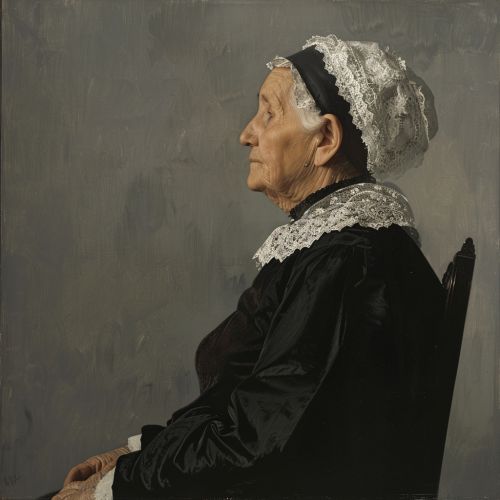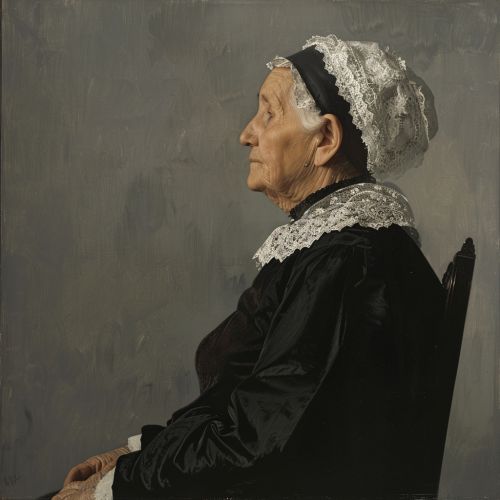James Abbott McNeill Whistler: Difference between revisions
(Created page with "== Early Life and Education == James Abbott McNeill Whistler was born on July 10, 1834, in Lowell, Massachusetts, USA. His father, George Washington Whistler, was a prominent civil engineer, and his mother, Anna Matilda McNeill, came from a wealthy Southern family. In 1842, the family moved to St. Petersburg, Russia, where George Whistler had been invited to work on the construction of a railroad. This period in Russia exposed young James to European art and culture, wh...") |
No edit summary |
||
| Line 15: | Line 15: | ||
Whistler's most famous work, "Arrangement in Grey and Black No. 1" (1871), commonly known as "Whistler's Mother," is a prime example of his mature style. The painting is notable for its subdued color palette and emphasis on form and composition. Whistler referred to his paintings as "arrangements" or "symphonies," highlighting his belief in the musical qualities of art. | Whistler's most famous work, "Arrangement in Grey and Black No. 1" (1871), commonly known as "Whistler's Mother," is a prime example of his mature style. The painting is notable for its subdued color palette and emphasis on form and composition. Whistler referred to his paintings as "arrangements" or "symphonies," highlighting his belief in the musical qualities of art. | ||
[[Image:Detail-97407.jpg|thumb|center|Portrait of an elderly woman seated in profile, dressed in black, with a white lace cap and collar, against a grey background.|class=only_on_mobile]] | |||
[[Image:Detail-97408.jpg|thumb|center|Portrait of an elderly woman seated in profile, dressed in black, with a white lace cap and collar, against a grey background.|class=only_on_desktop]] | |||
Another significant work is "Nocturne in Black and Gold: The Falling Rocket" (1875), which exemplifies Whistler's interest in [[Aestheticism]], a movement that prioritized beauty and visual pleasure over narrative content. The painting's abstract quality and use of color to evoke mood rather than depict reality were groundbreaking at the time. | Another significant work is "Nocturne in Black and Gold: The Falling Rocket" (1875), which exemplifies Whistler's interest in [[Aestheticism]], a movement that prioritized beauty and visual pleasure over narrative content. The painting's abstract quality and use of color to evoke mood rather than depict reality were groundbreaking at the time. | ||
Latest revision as of 23:47, 29 July 2024
Early Life and Education
James Abbott McNeill Whistler was born on July 10, 1834, in Lowell, Massachusetts, USA. His father, George Washington Whistler, was a prominent civil engineer, and his mother, Anna Matilda McNeill, came from a wealthy Southern family. In 1842, the family moved to St. Petersburg, Russia, where George Whistler had been invited to work on the construction of a railroad. This period in Russia exposed young James to European art and culture, which would later influence his artistic style.
Whistler's early education included private tutoring and attendance at the Imperial Academy of Fine Arts in St. Petersburg. After his father's death in 1849, the family returned to the United States, settling in Pomfret, Connecticut. Whistler briefly attended the United States Military Academy at West Point, but he was dismissed in 1854 due to poor grades and disciplinary issues.
Artistic Development
Whistler moved to Paris in 1855 to pursue a career in art. He enrolled at the École Impériale and studied under Charles Gleyre, a Swiss artist known for his classical style. During this period, Whistler was heavily influenced by the works of Gustave Courbet and the Realist movement. He also became acquainted with Henri Fantin-Latour and Alphonse Legros, forming a group known as the "Société des Trois."
In 1859, Whistler moved to London, where he would spend most of his life. His early works, such as "At the Piano" (1858-59), reflect his Realist influences. However, he soon began to develop his unique style, characterized by a focus on composition and tonal harmony.
Major Works and Style
Whistler's most famous work, "Arrangement in Grey and Black No. 1" (1871), commonly known as "Whistler's Mother," is a prime example of his mature style. The painting is notable for its subdued color palette and emphasis on form and composition. Whistler referred to his paintings as "arrangements" or "symphonies," highlighting his belief in the musical qualities of art.


Another significant work is "Nocturne in Black and Gold: The Falling Rocket" (1875), which exemplifies Whistler's interest in Aestheticism, a movement that prioritized beauty and visual pleasure over narrative content. The painting's abstract quality and use of color to evoke mood rather than depict reality were groundbreaking at the time.
Legal Battles and Later Years
In 1877, Whistler became embroiled in a famous legal battle with art critic John Ruskin. Ruskin had harshly criticized "Nocturne in Black and Gold," accusing Whistler of "flinging a pot of paint in the public's face." Whistler sued Ruskin for libel and won the case, but the damages awarded were minimal, and the legal costs bankrupted him.
Despite this setback, Whistler continued to produce significant works, including the "Peacock Room" (1876-77), a lavishly decorated dining room designed for the London home of shipping magnate Frederick Leyland. The room is a masterpiece of Art Nouveau design, featuring intricate patterns and a harmonious color scheme.
In his later years, Whistler focused on portraiture and printmaking. He was a master of etching and lithography, producing numerous prints that are highly regarded for their technical skill and artistic quality.
Influence and Legacy
Whistler's influence on the art world extends beyond his paintings. He was a key figure in the Aesthetic Movement, which sought to elevate the importance of beauty and artistic expression. His ideas about "art for art's sake" challenged traditional notions of art's purpose and paved the way for modernist movements in the 20th century.
Whistler was also an influential teacher and mentor. His "Ten O'Clock Lecture," delivered in 1885, articulated his artistic philosophy and inspired a generation of artists, including Walter Sickert and the members of the Camden Town Group.
Personal Life
Whistler's personal life was as colorful as his art. He was known for his wit and flamboyant personality, often engaging in public feuds with critics and fellow artists. He had numerous romantic relationships, including a long-term affair with his model and mistress, Joanna Hiffernan. In 1888, he married Beatrice Godwin, the widow of architect E.W. Godwin, but she died of cancer in 1896.
Death and Posthumous Recognition
James Abbott McNeill Whistler died on July 17, 1903, in London. He was buried in Chiswick Old Cemetery. Posthumously, Whistler's work has continued to be celebrated and studied. Major retrospectives of his work have been held at institutions such as the Tate Gallery in London and the National Gallery of Art in Washington, D.C.
